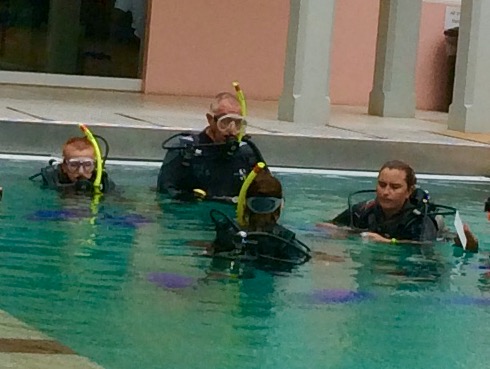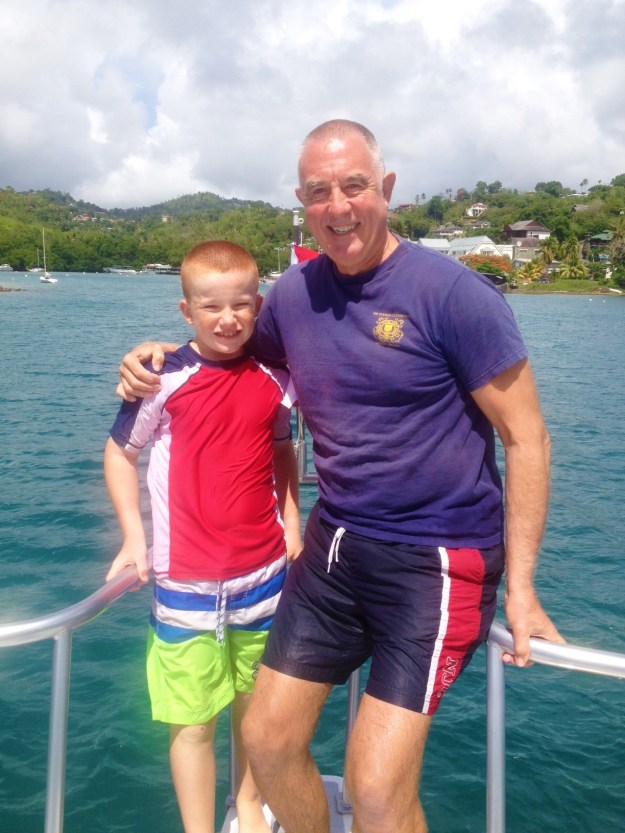Have you ever wondered what it would be like to breathe underwater? Well, I did. That is why, after having it highly recommended to us by some of our friends, my family and I signed up for the PADI (Professional Association of Dive Instructors) Open Water Dive course at Dive Saint Lucia. Dive Saint Lucia, in Rodney Bay, St. Lucia, was the nicest dive shop we have ever seen. All of the facilities were designed and built specifically with scuba diving training in mind. The dive boats are brand new and all of the equipment is first rate. As a result, we were looking forward to starting the dive course.
After completing the online Open Water Diver PADI course and final exam, we showed up at the dive shop ready to go. Our instructor (Julia) helped us pick out the equipment we would be using for the duration of the course.
Ronan only took the trial course in the pool so he will have an idea of what it will be like when he and our Mom get certified when we come back next year. Everyone in our group learned how to set up all of the equipment which would prove to be an essential skill during the course of our training.
To demonstrate that we were strong enough swimmers to dive, we had to swim 15 laps in the pool and tread water or float for 10 minutes.
After that, our group, plus the instructor and training instructor, did scuba exercises at the bottom of the pool. Our first breaths underwater were amazing!
We did exercises underwater like fill and clear your mask of water, surface with your buddy breathing from your octopus (alternate air source), and inflating and deflating our Buoyancy Control Devices (BCD). At the end of the first confined (in the pool) water dives we felt like we understood the material that was taught and were ready for the open water (ocean) dives the next day.
In the morning of the second day we had to do some drills in the pool before getting on the boat. We practiced the long step into the water which was the technique we would be using to get off the dive boat into the ocean.
After that we took a boat ride to the south side of the island to the dive site.
- Randy & Ryan getting ready to dive, St. Lucia
- OK & ready to dive, St. Lucia
We were one bay north of the Pitons. Once we were there we were already geared up so we got into the water.
We descended onto a sandy bottom and practiced some of the drills that we did in the pool in the ocean. Then, when we were done with the exercises, we swam underwater around the surrounding reef.
It was very cool! We saw moray eels, sea snakes, and sea spiders!
The deepest we went on our first open water dive was 12 meters (40 feet). That is the maximum that I am allowed to dive because I am still not old enough to be allowed to go the depth of an older (over 14) PADI open water diver, which is 20 meters (60 feet).
The second dive site was a ten minute boat ride north. We used the same procedure and got our gear ready before we got there so we could just get right in. When we jumped in we descended almost right after. Once we got to the bottom we did more scuba drill exercises. After completing those we did a big circle around the reef. We saw similar sea life to what we saw on the first dive. Later when we ascended we practiced the tired diver tow on the surface. Randy towed me a quarter mile back to the boat! The first two open water dives were amazing and we were excited that we had two more dives the next day.
The next day, when we got to the dive shop, we did not have to jump in the pool or set up gear. It was just straight to the boat after getting briefed on how to use an underwater compass. The dive sites on the second day were not as far but we did have to stop in Marigot Bay again to pick up some people. The first dive site was Anse Cochon north. Once we got off the boat and descended we practiced taking off our masks completely and putting them back on underwater and navigating underwater with a compass. Then, like the other dives, after doing the work we got to play by checking out the reef. On this dive we saw aquatic life like shrimp, jaw fish, and coral. After making our safety stop and ascending to the surface we did a drill where we swim staying on an assigned heading with the compass. The boat came and picked us up and brought us to the second dive site which was Anse Cochon south. The boat dropped a few people off in one spot, some other people off in another spot, and then finally we got to hop in. This was our last dive for the PADI Open Water Diver course. There were no drills or exercises on our last dive. We explored the huge reef along the coast line. In my opinion our last dive was the most fun and the coolest out of all the dives. We saw underwater plants that look like trees, flounder, and even lionfish!
When we surfaced we were happy because we were now PADI certified open water divers!
Learning to dive is an excellent accomplishment and we cannot wait to extend our knowledge and experience in the diving community!





























